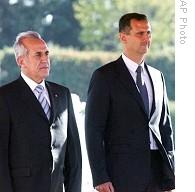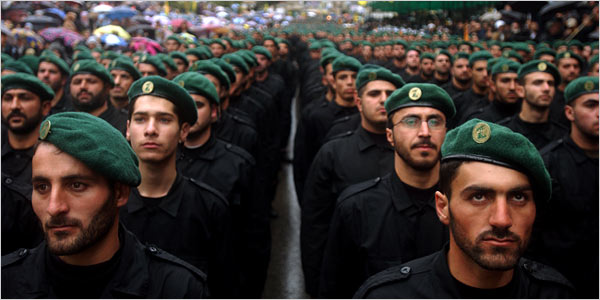| by Mahdi Darius Nazemroaya | |
 | |
| Global Research, January 17, 2009 | |
The March to War: Today the Gaza Strip, Tomorrow Lebanon…
In the Middle East, it is widely believed that the war against Gaza is an extension of the 2006 war against Lebanon. Without question, the war in the Gaza Strip is a part of the same conflict.
Moreover, since the Israeli defeat in 2006, Tel Aviv and Washington have not abandoned their design to turn Lebanon into a client state.
Prime Minister Ehud Olmert told France’s President Nicolas Sarkozy, in so many words, during his visit to Tel Aviv in early January that today Israel was attacking Hamas in the Gaza Strip and that tomorrow it would be fighting Hezbollah in Lebanon.[1]

Ehud Olmert and Nicolas Sarkozy
Lebanon is still in the cross-hairs. Israel is searching for a justification or a pretext to launch another war against Lebanon.
Washington and Tel Aviv had initially hoped to control Beirut through client political forces in the March 14 Alliance. When it became apparent that these political forces could not dominate Lebanon politically the Israeli military was unleashed on Lebanon with a goal of bringing about the ultimate downfall of Hezbollah and its political allies. [2] Areas where support for Hezbollah and its political allies were strongest saw the harshest Israeli attacks in 2006 as part of an attempt to reduce, if not remove, popular support for them.
After the 2006 war, the second Israeli defeat in Lebanon, Washington and Tel Aviv with the help of Jordan, the U.A.E., Egypt, and Saudi Arabia started arming their clients in Lebanon to wield an internal armed option against Hezbollah and its allies. In the wake of both the short-lived internal violence between the Lebanese National Opposition and the March 14 Alliance and the Doha Accord, which was reached in Qatar on May 21, 2008 as a result of the failure of this internal armed option against Hezbollah and its allies, the Israeli-U.S. objective to subdue Lebanon has been dramatically impaired.
A “national unity government” was formed in which the Lebanese National Opposition — not just Hezbollah — hold veto power through one-third of the cabinet chairs, including that of the post of deputy-prime minister.
The objective in Lebanon is “regime change” and to repress all forms of political opposition. But how to bring it about? The forecast of the 2009 general-elections in Lebanon does not look favourable for the March 14 Alliance. Without an internal political or armed option in Lebanon, which could result in the installation of a U.S.-sponsored “democracy,” Washington and its indefictible Israeli ally have chosen the only avenue available: a military solution, another war on Lebanon. [3]
Crossing Arms III: Israel Simulates a Two-Front War against Lebanon and Syria
This war is already in the advanced planning stage. In November 2008, barely a month before Tel Aviv started its massacre in the Gaza Strip, the Israeli military held drills for a two-front war against Lebanon and Syria called Shiluv Zro’ot III (Crossing Arms III).[4]
The military exercise included a massive simulated invasion of both Syria and Lebanon. Several months before the Israeli invasion drills, Tel Aviv had also warned Beirut that it would declare war on the whole of Lebanon and not just Hezbollah.[5]
Israel’s justification for these war preparations was that Hezbollah has grown stronger and become a partner in the Lebanese government since the Doha Accord. The latter was signed in Qatar between the March 14 Alliance and the Lebanese National Opposition. It is worth noting that Hezbollah was a member of the Lebanese coalition government prior to the 2006 Israeli war on Lebanon.
No doubt, Tel Aviv will also point to Hezbollah’s support of Hamas in Gaza as another pretext to wage under the banner of combating Islamic terrorism a pre-emptive war on Lebanon. In this context, Dell Lee Dailey the head of the counter-terrorism section of the U.S. State Department, had told Al-Hayat in an interview that an Israeli attack on Lebanon was “imminent” as part of the fight against terrorism. [6]
Blitzkrieg in the Making
Tel Aviv has been mapping a large-scale blitzkrieg against Lebanon as a whole, which includes an immediate land invasion. [7] Just before the Israeli massacre in the Gaza Strip started, Israeli officials and generals had promised that no Lebanese village would be immune from the wrath of Israeli aerial bombardments, regardless of religion, sect, and/or political orientation. [8]
In substance, Tel Aviv has promised to totally destroy Lebanon. Israel has also confirmed that in any future war against Lebanon, the entire country rather than Hezbollah will be the target. In practice, this was already the case in 2006’s Israeli aerial attacks on Lebanon. [9]
The Jerusalem Post quotes Brigadier-General Michael Ben-Baruch, one of the individuals who oversaw the invasion drills, as saying, “In the last war, we fired to disrupt Hezbollah activity,” and, “The next time we will fire to destroy.” [10]
In the wake of Israel’s 2006 defeat, the Israeli government admitted that its “big mistake” was it exercised restraint rather than attacking Lebanon with the full strength of its military. Israeli officials have intimated that in the case of a future war against the Lebanese that all civilian and state infrastructure will be targeted.
Beirut’s New Defence Doctrine: A Threat to Israeli Interests and Objectives to Control Lebanon
Why is Lebanon in the cross-hairs again?
The answer is geo-political and strategic. It is also related to the political consensus process and the upcoming 2009 general-elections in Lebanon. Following the formation of a unity government in Beirut under a new president, Michel Suleiman (Sleiman), a new proactive defence doctrine for the country was contemplated. The objective of this defence doctrine is to keep Israel at bay and bring political stability and security to the country.

President Michel Suleiman
At the “National Defence Strategy” dialogue, held by the 14 Lebanese signatories of the Doha Accord, all sides have agreed that Israel is a threat to Lebanon.
In the months prior to the Israeli military campaign against Gaza, important diplomatic and political steps were taken by Beirut. President Michel Suleiman accompanied by several cabinet ministers visited Damascus (his first bilateral state visit; August 13-14, 2008) and Tehran (November 24-25, 2008).

President Suleiman and Syrian President Al Assad
In turn, General Jean Qahwaji (Kahwaji) the commander of the Lebanese Armed Forces was also in Damascus (November 29, 2008) for consultations with his Syrian counterpart General Al-Habib. While in Damascus, General Qahwaji also met with General Hassan Tourkmani, the defence minister of Syria, and the Syrian President. [11] His trip followed the visit of Lebanon’s interior minister, Ziad Baroud, to Syria and was within the same framework. [12] Meanwhile, Lebanon’s defence minister, Elias Murr, went on an official visit to Moscow (December 16, 2008).
What started to emerge from these talks was that both Moscow and Tehran would provide weaponry to the Lebanese Armed Forces, which previously had been the recipients of lower-end U.S. made ordinance. The U.S. has always forbidden the Lebanese military from purchasing any heavy weapons that could challenge Israel’s military strength.
It was also revealed that Russia would donate 10 MiG-29 fighter jets to Beirut in line with Lebanon’s new defence strategy. [13] The use of the Russian MiG-29s would also entail the required installation of early warning and radar systems. Russian tanks, anti-tank rockets, armoured vehicles, and military helicopters are also being sought by Lebanon. [14]

Mig29
Iran has offered to supply the Lebanese military with medium-range missiles as part of a five-year Iranian-Lebanese defence agreement. [15] While in Iran, Michel Suleiman held talks with Iranian defence officials and went to an Iranian defence industry exposition.
While the talks with Moscow and Tehran aimed at arming the Lebanese Armed Forces, the talks with the Syrians were geared towards establishing and strengthening a joint security and defence framework directed against Israeli aggression. [16]
Integrating Hezbollah into the Lebanese Armed Forces
Moreover, Michel Aoun, leader of the Free Patriotic Movement and the Reform and Change Bloc in the Lebanese Parliament also visited Tehran (October 12-16, 2008; ahead of Michel Suleiman’s official visit), and later Damascus (December 3-7, 2008). [17] Michel Aoun who is a central figure in the “political consensus” has endorsed and reaffirmed his political alliance with Hezbollah.

Michel Aoun
While calling for the peaceful disarmament of Hezbollah within a Lebanese defence strategy, he has accepted that Hezbollah fighters will eventally integrate into Lebanon’s army. This disarmement process would only occur when the time is right and Israel no longer poses a threat to Lebanon. Hezbollah has broadly agreed to this, if and when there no longer exists an Israeli threat to the country’s security. This position on Hezbollah’s arms is spelled out in clause 10 (The Protection of Lebanon) of the February 6, 2006 memorandum of understanding (MoU) with Hezbollah that Michel Aoun signed on behalf of his political party, the Free Patriotic Movement.
Following his return from Tehran, Aoun also presented his case for the formation of a new Lebanese defence strategy and promised that the outcome of his visit to Iran would materialize in about six months. Aoun has also said that Iran, as the “major regional power between Lebanon and China” is of strategic importance to Lebanese interests. [18]

Hezbollah Paramilitary Forces
Washington’s political cohorts in Lebanon are alarmed at the direction Lebanon is taking under its new defence strategy. They have criticized weapons purchases from Iran and defensive cooperation with Syria. This includes attacks on General Jean Qahwaji’s visit to Syria, which was mandated by the entire Lebanese cabinet. [19] Additionally, within these pro-U.S. forces in Lebanon there has been a push for a “Swiss-like” “neutral defence policy” for Lebanon within the Middle East. Such a “neutral” position would benefit the U.S. and Israel geo-politically and strategically. Needless to say, with the threat of Israeli military aggression looming, this position is proving to be rather unpopular within Lebanon.
Ending Israeli-American pressure on Beirut to Naturalize Palestinian Refugees
The formation of a new proactive defence doctrine implies that Hezbollah fighters would be incorporated in the Lebanese Armed Forces and that the existing paramilitary forces of Hezbollah would be disbanded once certain conditions are met.
Therefore, one of Lebanon’s key political questions would be resolved. With the integration of Hezbollah fighters into the country’s army together with military aid from Russia and Iran, Lebanon would acquire defensive capabilities, which would enable it to confront the threat of Israeli military aggression. These developments, which go against the prevailing pattern of U.S. client regimes in the Middle East modelled on Egypt and Saudi Arabia, have sounded an alarm bell in Tel Aviv, Washington, and London.
In response to Lebanon’s rapprochement with Russia and Iran, two senior US State Department officials were rushed to Beirut in December.[20] During this mission, Dell Lee Dailey and David Hale, respectively Coordinator of the State Department’s Office of Counterterrorism and Deputy-assistant Secretary responsible for Middle Eastern affairs, renewed the veiled threats of an Israeli attack against Lebanon, while casually placing the blame on Hezbollah.[21] These threats are aimed at Lebanon as a whole. They are intended to disrupt the creation of Lebanon’s new defence doctrine.
The clock is ticking for Israel, the U.S., and NATO to obstruct the implementation of Beirut’s new national defence doctrine.
Israel would no longer have any justifications for carrying out military incursions into Lebanon if Hezbollah were to become a full political party under a new Lebanese defence strategy. Moreover, if Beirut were able, under a new defence arrangement, to protect its borders against Israeli military threats it would not only end Tel Aviv’s ambitions to politically and economically dominate Lebanon, but it would also end Israeli pressure on Lebanon to naturalize the Palestinian war refugees waiting to return to their ancestoral lands that are occupied by Israel.
Clearly the issue of Palestinian naturalization in Lebanon is also tied to Lebanon’s political consensus process and new defence strategy and was discussed by Michel Suleiman with Iranian officials in Tehran. [22]
The Middle Eastern Powder Keg: A World War III Scenario?
In 2006, when Israel attacked Lebanon, the war was presented to international public opinion as a conflict between Israel and Hezbollah. In essence the 2006 war was an Israeli attack on all of Lebanon. The Beirut government failed to take a stance, declared its “neutrality” and Lebanon’s military forces were instructed not to intervene against the Israeli invaders. The reason for this was that the political parties of the Hariri-led March 14 Alliance that dominated the Lebanese government were expecting the war to end quickly and for Hezbollah (their political rival) to be defeated, and eventually excluded from playing a meaningful role on the Lebanese domestic political scene. Exactly the opposite has occurred since 2006.
Moreover, had the Lebanese government declared war on Israel, in response to Israeli aggression, Syria would have been obligated through a Lebanese-Syrian bilateral treaty, signed in 1991, to intervene in support of Lebanon.
In the case of a future Israeli war against Lebanon, the structure of military alliances is crucial. Syria could indeed intervene on the side of Lebanon. If Syria enters into the conflict, Damascus could seek the support of Tehran in the context of a bilateral military cooperation agreement with Iran.
A scenario of escalation is, therefore, possible, which could potentially spin out of control.
If Iran were to enter on the side of Lebanon and Syria in a defensive war against Israel, the U.S. and NATO would also intervene leading us into a broader war.
Both Iran and Syria have military cooperation agreements with Russia. Iran also has bilateral military cooperation agreements with China. Iran is also an observer member of the Shanghai Cooperation Organization (SCO). Iran’s allies including Russia, China, the member states of the Collective Security Treaty Organization (CSTO), and the Shanghai Cooperation Organization (SCO) could all be drawn into the broader conflict.







